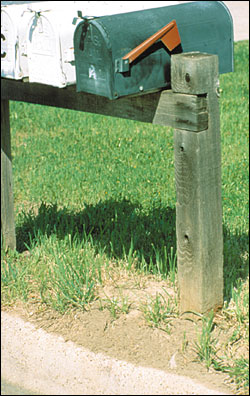
- Introduction
- Management Options
- Organizing a Community-Wide Fire Ant Suppression Program
- Fire Ant Treatment Methods
- Fire Ant Biology and Identification
- Medical Problems
- History of Control Efforts
- Fire ant insecticides, modes of action and formulations
Introduction
The two species of imported fire ants (red imported fire ant, Solenopsis invicta Buren, and black imported fire ant, Solenopsis richteri Forel) and their hybrid are nuisance insects whose stings can cause serious medical problems. Imported fire ants interfere with outdoor activities and harm wildlife throughout the southern United States. Ant mounds are unsightly and may reduce land values. Although fire ants do prey on flea larvae, chinch bugs, cockroach eggs, ticks and other pests, the problems they cause usually outweigh any benefits in urban areas. While it is not possible to eradicate this species (see History of Control Efforts), controlling fire ants is highly desirable. The best control programs use a combination of non-chemical and chemical methods that are effective, economical and least harmful to the environment.
Integrated Pest Management (IPM)
Integrated Pest Management, or IPM, is a systems approach to managing insect, mite, disease and weed pests. It uses a combination of the most compatible and ecologically sound pest suppression tactics to keep pest populations below levels that cause problems. IPM uses cultural, biological and chemical methods. This bulletin describes site-specific, goal-oriented management programs for urban sites where fire ants occur. The goal of IPM is to prevent the problems caused by unacceptably large numbers of fire ants, rather than eliminating all ants from the ecosystem.
USDA Quarantine Program
Because fire ants are easily transported in nursery stock and soil, the U.S. Department of Agriculture’s Animal and Plant Health Inspection Service (USDA, APHIS) developed a quarantine program for this pest in the 1950s. The USDA Imported Fire Ant Quarantine program is administered by state regulatory agencies (e.g., Alabama Department of Agriculture and Industries, Arkansas State Plant Board, Georgia Department of Agriculture, Louisiana Department of Agriculture and Forestry, Oklahoma Department of Agriculture, Tennessee Department of Agriculture, Clemson University Department of Plant Industry, Texas Department of Agriculture). The purpose of the quarantine program is to minimize the spread of imported fire ants by requiring proper inspection and treatment of all nursery stock, turfgrass, hay and other articles shipped out of quarantined areas (Fig. 1). Inspectors also survey non-quarantined counties for fire ants and occasionally treat small, isolated infestations. The public should do its part to avoid spreading the ants by not transporting or purchasing fire ant infested articles.
 Figure 1. National quarantine map.
Figure 1. National quarantine map.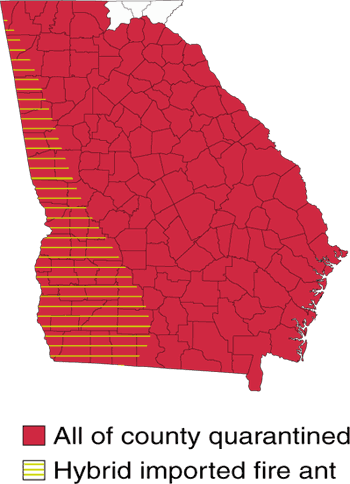 Figure 1a. Georgia quarantine map.
Figure 1a. Georgia quarantine map.
Management Options
Properly identifying the ant species is the first step in determining whether and how to control them (see Fire Ant Biology and Identification). In the following sections are options for managing various kinds of imported fire ant problems. There may be other effective methods not mentioned. There is rarely a single best method of control.
Note: See Fire Ant Treatment Methods for information about biological control, home remedies, and insecticide products and their proper use. Use only pesticides labeled for the location or “site” you want to treat. For instance, DO NOT use a product in your vegetable garden unless that site is listed on the label.
Home lawns and other ornamental turf
Fire ants commonly infest lawns, school yards, athletic fields, golf courses and parks, where they pose a medical threat to people and animals. Their mounds also detract from the appearance of the landscape and can damage lawn care equipment.
Treatment options
Program 1. The “Two-Step Method”:
This program suppresses ants in ornamental turf and non-agricultural lands, including roadsides. It is also suitable for pasture and rangeland, provided that the products selected are specifically registered for use in these sites. It is best suited to medium-sized or large areas, and the cost is moderate. This approach is not suggested for previously untreated areas with large numbers of native competitor ants and few fire ant mounds (20 per acre or fewer). The goal of this program is to reduce fire ant problems while minimizing the need to treat individual mounds.
The two steps involve: 1) broadcasting a bait product (see section on proper use of baits), followed by; 2) treating nuisance mounds with a faster acting individual mound treatment or with a mound re-treatment of the bait:
| 1 |
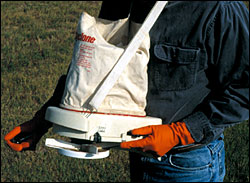 |
| 2 |
Step 2. Wait several days or more after applying the bait, and then treat nuisance ant colonies (such as those in sensitive or high traffic areas) using an individual mound treatment method (see Program 2, Step 1, below). Otherwise, be patient and wait for the bait treatment to work. Any nuisance mounds that escaped the effects of the bait treatment, or colonies migrating into treated areas, should be treated as needed. In large areas individual mound treatment may not be feasible and routine broadcast bait treatments alone may provide sufficient control. Repeat the bait application when ants re-invade the area and mound numbers reach about 20 to 30 per acre. Bait products do not protect against reinvasion by ant colonies from surrounding land or by newly mated queens. Ant populations can fully recover within 12 to 18 months of the last bait treatment. Low-lying, moist and flood-prone areas are more prone to re-infestation. |
Program 2. Individual Mound Treatments:
This approach is best used in small areas of ornamental turf (usually 1 acre or less) where there are fewer than 20 to 30 mounds per acre or where preservation of native ants is desired. This program selectively controls fire ants, but rapid re-invasion should be anticipated. It generally requires more labor and monitoring than other programs, and is not suggested for heavily infested areas.
| 1 |
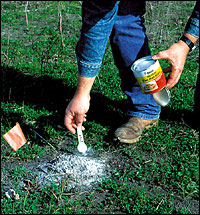 Step 1. Treat undesirable fire ant mounds using an individual mound treatment. Products are applied as dusts, granules, granules drenched with water after application, liquid drenches, baits, or aerosol injections. Non-chemical methods such as drenching mounds with very hot water also may be used. |
| 2 |
Step 2. Continue treating undesirable mounds that appear, as needed. |
Program 3. The “Ant Elimination Method”:
This program eliminates nearly all ant species in treated areas. Its effects are more rapid than those of other programs, and it minimizes re-invasion of treated areas as long as the contact insecticide remains effective. However, it is more expensive, uses more insecticide, and has greater environmental impact. This approach is frequently used by commercial applicators.
| 1 |
Step 1. (Optional). Broadcast a bait-formulated insecticide in areas where there are many mounds (more than 20 per acre), or individually treat fire ant mounds. Wait 2 to 3 days after applying a bait before conducting the next step. |
| 2 |
Step 2. Apply a contact insecticide to turfgrass every 4 to 8 weeks, or when ant activity is detected. Liquid or granular products that can be evenly applied to an area are appropriate for this treatment. Some product labels instruct the user to spray “ant hills.” Although initial surface treatment may not eliminate ants located deep in mounds, routine reapplication will eventually eliminate colonies. |
Program combinations:
Any of the three programs can be used on specific sites within a managed area where different levels of fire ant control are desired. On golf courses, for instance, Program 3 might be suitable for high use areas such as putting greens and tee boxes. In fairways and rough areas, Program 1 may be sufficient. On athletic fields, fire ants must be eliminated, so Program 3 should be followed. Control programs should be started 6 to 8 weeks before athletic fields will be used. People with severe allergies to fire ant stings should use Program 3 for their lawns or consider using a bait on a calendar schedule.
Homes and buildings
Fire ants from colonies close to homes and other buildings sometimes forage indoors for food and moisture, particularly during the hot, dry, summer months. Entire colonies occasionally nest in wall voids or rafters, or behind large appliances, sometimes moving into buildings during floods or drought. They are a nuisance and can threaten sleeping or bed-ridden individuals and pets.
Treatment options
| 1 |
If ants are entering or could enter the home from outdoor colonies, treat mounds near the building using one of the programs described for Home Lawns and Other Ornamental Turf Areas. A contact insecticide with a long residual effect, such as chlorpyrifos, diazinon or a pyrethroid, also can be applied as an outside barrier around the base of the home. Caulking cracks and crevices also may help prevent ants from entering. |
| 2 |
If fire ants are foraging indoors and do not pose an immediate threat to residents or pets, use a bait labeled for use indoors. Examples are baits containing abamectin (PT 370-Ascend®), hydramethylnon (MaxForce® Granular Insect Bait or Amdro®), or bait stations containing hydramethylnon (MaxForce®, Combat®) or sulfluramid (Raid® Ant Baits Plus). Fire ant baits eliminate the colony. Bait products not specifically registered for imported fire ant control may or may not control them. |
| 3 |
Follow trails of foraging ants to colonies located indoors and treat them with contact insecticide dusts or sprays (containing bendiocarb, chlorpyrifos, pyrethroids and others) injected into the nest. Treating only ant trails will not eliminate the entire colony and interferes with the use of baits. |
| 4 |
Vacuum indoor ant trails and dispose of the vacuum bag immediately. Treat the source colony or entry site of the trail using the options above. |
Electrical equipment and utility housings

Fire ants frequently infest electrical equipment. They chew on insulation and can cause short circuits or interfere with switching mechanisms. Air conditioners, traffic signal boxes, and other devices can be damaged. Fire ants also nest in housings around electrical and utility units. The ants move soil into these structures, which causes corrosion, shorting, and other mechanical problems.
Note: For safety reasons, an electrician or a licensed pest control operator should treat infested electrical equipment. Specialized products and training are necessary to treat these sites safely and effectively.
Treatment program
| 1 |
Step 1. Turn off all electrical service before starting. Use an individual mound treatment method to eliminate colonies around electrical and plumbing casings and housings. Injectable aerosol products containing pyrethrins, or similar products, give rapid control. Hydramethylnon, abamectin or spinosad baits applied to individual fire ant mounds will control colonies in about 1 week, even if a colony is located within the structure. Do not use liquid drenches, sprays, or products that may damage insulation around electrical fixtures. Treating a larger area around the electrical structure is optional. Mound and area treatments are described in the section on Home Lawns and Other Ornamental Turf Areas. Be extremely careful when applying pesticide around water systems and well heads to prevent contamination of wells and ground water. Once ants are eliminated, remove debris and soil from the equipment housings to reduce the possibility of short circuits. |
| 2 |
Step 2. Treat the inside of equipment housings with products labeled for this use, such as State Fire Ant Killer® (containing resmethrin), Rainbow Insect Control® (chlorpyrifos), Stutton® JS 685 Powder (synergized pyrethrins and silica gel), Ascend® (abamectin), or Elastrel® or Hot Shot® No-Pest Strip insecticide (dichlorvos). |
Maintenance
After ants are removed from the electrical equipment, prevent reinfestation and damage. Where possible, seal all sensitive electrical components, particularly those that are not insulated. Examples are plastic housings containing contact points of switches, relays and circuit breakers.
Spray long-residual contact insecticides around housings, making sure to avoid the electrical circuitry or components. Apply specifically labeled products to the housing itself or to the mounting pad (see Step 2 in the treatment program above).
Home gardens
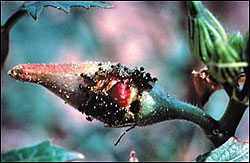
Ants occasionally feed on vegetable plants in home gardens. They tunnel into potatoes underground and feed on okra buds and developing pods. The worst damage usually occurs during hot, dry weather. Ants may be a nuisance to gardeners during weeding and harvesting. Ants prey on some garden pests such as caterpillars, but protect or “tend” others, such as aphids, by keeping natural enemies away.
Treatment options
| 1 |
Ant mounds can be shoveled out of the garden or treated with very hot water, taking care not to disturb plants or allow hot water to contact them. |
| 2 |
Only a few products (those containing carbaryl, pyrethrins, pyrethrins plus diatomaceous earth or rotenone) have been registered for treating ants in vegetable gardens. |
| 3 |
Granular products containing carbaryl (Sevin®) or carbaryl plus metaldehyde have been registered for “ants” foraging in the garden. Products containing diazinon or chlorpyrifos are registered for “soil insects” in home gardens; they can be applied before planting and may provide some temporary control of foraging fire ants. Follow all preharvest intervals indicated on the label when using a pesticide on and around food plants. |
| 4 | The bait product Extinguish®, which contains methoprene, is now registered for use in “cropland.” Bait products, however, are not specifically registered for use inside home vegetable gardens, though they can be applied outside the garden’s perimeter. Foraging ants from colonies both inside and outside the garden will collect the bait and take it to their colonies. |
| 5 |
To keep ants from entering a garden, manage them properly in the surrounding landscape. Products registered for controlling ants in turf grass can be applied outside the perimeter of the garden as a barrier, or used to treat individual mounds near the garden. |
Compost piles, mulched flower beds, pavement cracks, etc.
Fire ants invade compost piles and mulched flower beds seeking warmth and moisture. They also nest under cracked pavement, removing dirt from underneath sidewalks and roadways and aggravating structural problems. Colonies in these sites may be difficult to locate precisely. When the exact location of a fire ant colony is unknown, treat the area of greatest ant activity with a fast-acting bait product containing hydramethylnon, abamectin or spinosad.
Around bodies of water

Fire ants require water to survive and are often found near creeks, run-off ditches, streams, rivers, ponds, lakes and other bodies of water. If surface water is unavailable, they tunnel down to the water table many feet below the ground. Every effort must be made to avoid contaminating water with pesticides. Fire ant bait products contain very small amounts of active ingredients and can be applied close to shorelines, but not directly to the water. To decrease the risk of runoff into waterways, apply baits when ants are actively foraging. Near water or in drainage or flood-prone areas, individual mound treatments should be made with care, using products such as acephate (Orthene®) that have low toxicity to fish. Pyrethrins and rotenone products should not be used because they are highly toxic to fish. Do not apply surface, bait or individual mound treatments if rain is likely to occur soon after treatment.
Organizing a Community-Wide Fire Ant Suppression Program
Fire ant management programs can be successful, but because they are usually implemented by individual landowners and managers, reinfestation from nearby untreated areas generally occurs. Many of the baits on the market today came from efforts to develop products suitable for area-wide treatment programs, and are best suited for large-scale use.
Despite great public concern, neither the state nor federal government is currently planning or funding any large-scale fire ant treatment programs. It is up to local organizations to decide on the best IPM strategy for a particular situation. With the help of experts in the field, any group can organize an effective fire ant suppression program.
The Two-Step Method (Program 1) for Home Lawns and Other Ornamental Turf Areas is often the method best suited for community-wide treatment. Homeowners and land managers may still need to treat a few mounds (step 2) between large-scale bait treatments, but they will need to treat far fewer than if no bait had been applied. In other areas, where ant surveys have documented that there are few imported fire ants and many competitor ant species, Program 2, or program combinations, may be more suitable.
Matching the program to your resources and needs
Basic education is critical. If you treat and your neighbor does not, you will find your yard is quickly re-infested. If you educate your neighbors, you can coordinate your battle against the imported fire ant more effectively and efficiently. Developing leadership in some neighborhoods may be difficult, but not an insurmountable problem. Many states have agencies that can help in organizing communities, be it a neighborhood watch program or a fire ant management program. There are many ways people can work together to conduct community-wide fire ant suppression programs.
Coordinating neighborhood treatment
Homeowners can coordinate treatment of their entire neighborhood each year, usually once in the fall and once in the spring. Each homeowner should receive instructions on:
1) appropriate fire ant bait products to purchase; 2) how to properly broadcast a bait; and 3) treatment date(s). Each homeowner is expected to make his own applications or arrange for treatment on the designated treatment date(s). Contingency dates should be scheduled in case rain is forecast or the temperature is less than 65 or greater than 90 degrees F on the primary treatment date. Volunteers can be enlisted to treat common areas, vacant lots and yards of homeowners who are unable to make applications themselves.
Working through homeowner associations
Homeowner associations might contract with a local commercial applicator to broadcast fire ant bait over the entire subdivision periodically, including common areas and medians. The contractor should be asked to evaluate the area and re-treat areas as needed.
Working through city and county government

Some states have legislation or other laws in place that could aid your community in organizing treatment programs, (e.g., fire ant abatement legislation in Arkansas, or public health laws in many states). With enough citizen support, local governments can establish fire ant control programs that treat public areas and perhaps allow homeowners to have their properties treated for a fee. The municipal or county government could contract with a commercial pest control applicator. Advertising should encourage entire blocks or neighborhoods to sign up, because the larger the area treated, the longer lasting the control. Treatments would include annual broadcast applications of a fire ant bait, follow-up checks, and possibly individual mound treatments as needed. The fee paid by individual landowners could pay for the program.
A city government might help coordinate the aerial application of a fire ant bait to an entire town. Areas where baits must not be applied, such as swimming pools and vegetable gardens, would have to be covered during application. Widespread citizen support would be essential. The aerial applicators contracted by the city would have to agree to modify equipment to apply the recommended amount of bait per acre, heed the FAA flying height over populated areas, and avoid bodies of water and agricultural areas where food is produced. Make sure the product(s) used is registered for application to the sites treated. Many volunteers would be needed to successfully coordinate and implement this program.
Planning to ensure success
Determine treatment areas.
Some localized areas, even within heavily infested regions, have little or no imported fire ant infestation. Surveys should be conducted to determine if the number of imported fire ant mounds is high enough to justify treatment, or what type of treatment is necessary.
Respect individual differences.
Sensitivity to fire ants and to the use of insecticides varies dramatically from person to person. Some individuals might not want to participate in a control program because they believe fire ants are not a problem and serve useful purposes, or because they are opposed to using insecticides, natural or otherwise, on their property. At the other extreme are people who want no fire ants on their property and don’t care about the methods used to achieve that goal. Participation in an area-wide program should be voluntary or decided upon through a democratic process.
Promote education and recognize limitations.
The strengths and limitations of the program should be acknowledged. For instance, a broadcast bait will eliminate most (usually 90 to 95 percent) of the fire ant mounds in an area temporarily (6 to 18 months). It will not eradicate them permanently. The speed at which suppression will occur is rather slow. Periodic, coordinated re-application will be necessary to maintain control. Between broadcast treatments, some individual colonies may require individual mound treatment. Properties that border untreated areas such as agricultural lands, water edges, flood plains and wilderness will likely be reinfested unless the borders of these areas are treated to form a barrier or buffer zone.
Follow pesticide laws and regulations.
In each state there is an agency that regulates the commercial application of pesticides (e.g., Structural Pest Control Board in Texas, Louisiana Dept. of Agriculture and Forestry). Although you can apply insecticides on your own property, you can not treat other yards in the neighborhood for a fee without a license. State laws mandate that anyone applying insecticides for a fee be licensed and insured. Anyone using “restricted use” insecticides must have a valid commercial or non-commercial pesticide applicator’s license. In some states, there are special regulations governing the use of pesticides to treat public school grounds.
Read and retain the insecticide product label.
Those who use insecticides must keep the label with the product. Never purchase a large quantity of insecticide and repackage, divide, or store it in a container without the label. Always follow the directions on the product label.
Take bids and review credentials.
Before contracting with a commercial applicator company or private pest control operator, get several bids based on the specific services you require. These firms must be licensed by the appropriate state agency.
Fire Ant Treatment Methods
Treatment methods and products vary greatly in effectiveness, speed of activity, practicality (labor requirements), toxicity to the user and the environment, compatibility with other options, and cost. Carefully study available treatment methods and their proper use in order to choose the best one for a particular situation. Many methods and products have been evaluated. Information is available from county Extension agents and Extension entomologists. Individual mound treatment cost ranges from about $0.15 to more than $1.00 per mound, and bait treatments can cost $8.00 per acre or more.
Natural and biological control
A number of organisms kill newly mated fire ant queens. These include birds, lizards, spiders, toads, dragonflies, robber flies, other ant species, and fire ants from surrounding colonies. Animals that eat ants, such as armadillos, may disturb mounds and eat some workers, but they are not really useful in control.
Some parasites and pathogens are known to attack ants, and several have been marketed for fire ant control. The predatory straw-itch mite, Pyemotes tritici (Lagreze-Fossat and Montane), that feeds on and paralyzes developing fire ants, has not proven to be effective when applied as directed and is potentially hazardous to the user. Parasitic nematodes (e.g., Steinernema spp.) are roundworms that seek out and enter insects, paralyzing them and developing in their bodies. Species and strains vary in their effectiveness. Strains tested to date caused ants in treated mounds to temporarily move away from the treated mound, but few colonies were actually eliminated. Parasitic fungi (e.g., Beuvaria bassiana) strains and formulations are also being evaluated as individual mound and broadcast bait treatments. The most effective biological control organisms for large-scale programs will likely be those that spread by themselves from mound to mound and persist from year to year. Several are being evaluated, including parasitic phorid flies, a protozoan disease of fire ants called Thelohania, and parasitic ants.
It is hoped that introducing natural enemies of fire ants into the United States may someday help to control them, although natural enemies will not eliminate fire ants. In South America, where fire ants have many natural enemies, the ants are still present, but occur in lower numbers.
Currently, the best biological control method for fire ants is to preserve native and exotic ant species that compete with them for food and nesting sites. One way to preserve native ants is the judicious use of insecticides.
Physical and mechanical methods
Pouring very hot or boiling water on a mound is a fairly effective treatment, particularly at times when ants are close to the mound surface, such as on a cool, sunny morning. Approximately 3 gallons of very hot (almost boiling) water poured on each mound will eliminate about 60 percent of the mounds treated. Be careful handling large volumes of hot water to prevent serious burns, and keep hot water off of desired plants and grass.
Sometimes it may be sufficient to move colonies away from sensitive areas such as gardens. Disturbing or knocking down mounds frequently will cause colonies to move. Some people believe shoveling one mound on top of another will force ants to kill each other, but this is not true.
Certain barriers can keep ants out of sensitive areas such as duck nesting boxes or greenhouse benches. Talcum powder and Teflon®-like tape or spray products can be used on vertical surfaces, but these treatments lose their effectiveness in humid or damp conditions. Tanglefoot®, a petroleum-based sticky material available as a gel or aerosol, is effective temporarily until it becomes coated with dust and other debris. Plates or wires heated to about 140 degrees F form a hot barrier that ants will not cross.
Control devices
Various mechanical and electrical products have been marketed for fire ant control. One device is designed to electrocute fire ant workers as they climb onto an electric grid inserted into the mound. It will kill many worker ants, but the queens and brood are unaffected. Similar devices placed in utility housings may, however, be useful as ant “decoys” or “traps” and are being evaluated to determine if they can protect electrical equipment. There are vibrating and sound-producing units designed to repel colonies, and devices that use microwaves or explosive elements to heat mounds or blow them up. Such products are often marketed without scientific evaluation. The fact that a “control” device is on the market does not indicate that it is effective. These products may kill some ants, but rarely eliminate a colony. Deceptive or fraudulent claims concerning fire ant control devices should be reported to the state’s Attorney General or the Federal Trade Commission.
Home remedies
In addition to very hot or boiling water, other “home remedies” have been tried. While these methods sometimes appear to work, they rarely eliminate colonies. Usually, the ant colony simply moves to a new location because of the disturbance, or the queen and a few workers temporarily remain hidden underground.
Gasoline and other petroleum products do kill some fire ant colonies. However, petroleum products are dangerously flammable or explosive, kill grass and plants around the treated mounds, and can seriously pollute the soil and ground water. Use of petroleum products, solvents, battery acids, bleaches or ammonia products can be dangerous and is strongly discouraged, except when they are ingredients in a registered pesticide product accompanied by usage directions.
Soap solutions, cleaning products or wood ashes soaked into the mound are believed to remove the protective oil coating from the ants. However, their effectiveness in killing colonies is not documented.
Sprinkling grits or other solid food substances onto fire ant mounds is ineffective. In theory, the ants eat the grits, which then swell and rupture the ants’ stomachs. In fact, only the last stage of the developing fire ant is known to digest solid food. All other life stages feed only on liquids or greasy materials. Some natural substances found in crushed or grated citrus peels are toxic to fire ants. Effective formulations and application techniques for these naturally-occurring chemicals (e.g., Citrex™ containing d-limonene) have been and are being developed.
“Organic” insecticides
Any chemical product sold with a claim that it kills fire ants must be registered by the Environmental Protection Agency (EPA) or approved by the appropriate state regulatory agency. Several products said to be “organic” (of natural origin) are currently marketed for fire ant control (see Table 1 for naturally produced metabolite and botanical products). All of these products are registered by the EPA as pesticides and some are very effective. However, they are not necessarily safer than other insecticides, and should be used with care.
Chemical control
Pesticides are products designed to kill target organisms. An insecticide is a pesticide formulated to kill insects. Chemical insecticides (both “organic” and synthetic) continue to be the main method of battling fire ants. Insecticides registered by the EPA are considered to pose minimal risk to the user and the environment when used as directed. Insecticide applications can be aimed at the foraging ants and/or at the entire colony. Table 1 lists fire ant insecticides by generic names of active ingredients. Carefully follow directions on the product label for the proper method of application, the use of protective clothing, re-entry intervals, and watering practices before and after treatment.
Baits
Most conventional bait formulations combine pesticide ingredients with soybean oil, which is absorbed onto processed corn grit. Soybean oil is an attractive food for ants that is important to the success of the bait. Because these baits are granular in texture, be careful not to confuse them with granular products that contain contact insecticides (see Table 1). Fire ant baits should have the word “BAIT” clearly listed on the label. Baits can be applied as spot treatments to individual mounds or broadcast over larger areas. To achieve satisfactory results:
| 1 |
Use fresh bait, preferably from a just opened container or one which has been tightly resealed and stored for no more than 2 years. Purchase only enough bait to make one treatment and do not store large quantities once the containers have been opened. Bait is collected by ants only when it is fresh. It is then carried back to the colony and shared with other members of the colony. Rancid or stale bait is ignored by foraging ants. To check the quality of your bait, place a little near an ant mound to see if ants are attracted to it, as described below. |
| 2 |
Apply when worker ants are actively foraging. This can also be determined by leaving a small pile, e.g., 1 to 2 tablespoons, of bait in the area to be treated. When ants are seen actively removing the bait 10 to 30 minutes later, you will know that the bait is attractive to ants and that ants are foraging. You can also use tuna fish, pet food or potato chips to see if ants are foraging. Foraging activity slows when soil temperature is lower than 65 to 70 degrees F or higher than 90 degrees F. In mid-summer, apply bait in late afternoon or early evening, because foraging ants are less active during the heat of the day. |
| 3 |
Apply baits when the ground and grass are dry and no rain is expected. |
| 4 |
Do not mix bait with other materials such as fertilizer or seed. |
| 5 |
Use appropriate application equipment and calibrate it properly. Differences in the oiliness of bait brands and production batches can cause variations in applicator output. Temperature and humidity also affect the rate at which bait flows through the applicator opening. The speed at which the applicator is moving is an important factor, particularly with factory-calibrated settings. Over-application provides little or no increase in control and adds greatly to the cost. Under-application may decrease effectiveness. |
The availability of bait products is a problem, especially in areas recently invaded by the fire ant. If you can not find some of the products mentioned in this publication, contact the store manager, visit your local co-op, or contact your county Extension agent to determine if the product is available in your area. Sometimes many of the bait products are sold only through specialty stores such as lawn and garden supply stores or pesticide wholesalers that sell professional products.

Hand-operated spreaders such as the Ortho® Whirlybird, and Republic or Scott’s Hand-held Spreader, are the least expensive applicators and are adequate for treating small areas. The operator can walk or ride on the back of a vehicle. Some push-type applicators, such as Spyker® Models 24 and 44, also may be suitable, but some modification (attach fire ant plate) is required to keep from applying too much material. Most rotary and drop-type fertilizer spreaders will not apply fire ant baits at the recommended rate.
Electric spreaders such as the Herd® Model GT-77A or similar applicators are best for treating large areas. These spreaders have vibrating opening plates that prevent clogging. Swath width is either pre-set or adjustable with a rheostat. Applicators can be mounted on any vehicle that will maintain a low speed. Do not use ground-driven or power take off-driven equipment, because it can rarely be set to apply such a low rate. Aerial application requires some modifications to the aircraft and application equipment. A description of these relatively simple modifications and calibration methods can be obtained from bait product manufacturers.
In addition to their use as a broadcast treatment, baits can be used for an individual mound treatment or spot treatment. Compared to other mound treatment products, baits cause less hazard to the environment and less mound relocation. Several bait products (hydramethylnon, sulfluramid) are available in bait stations that you place where ants are foraging (indoors or outdoors). Bait products containing hydramethylnon, abamectin or spinosad used to treat individual ant colonies work faster than when broadcast-applied. This is, however, not the case with insect growth regulator (IGR) baits containing fenoxycarb, methoprene or pyriproxyfen. Apply bait products as directed on the product label.
Individual mound treatments with contact insecticides
In addition to baits, mound treatment insecticides are formulated as dusts, liquids, granules and aerosols. Their effectiveness depends on proper application. Contact insecticides must contact ants to work and should be applied during times of the year (and times of the day) when ants are close to the mound surface. It is also important not to disturb the mound during treatment if this is stated on the product label. Individual mound treatment selectively eliminates only the ant colonies treated, and preserves desirable competitor ant species.
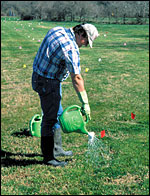
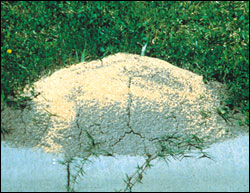 Do not apply more products than specified on the label. Water it properly.
Do not apply more products than specified on the label. Water it properly.
Mound drenches
Although a few are ready-to-use, most fire ant mound drenches are formulated as liquid concentrates that must be diluted in the amount of water specified on the label. Avoid skin contact with the concentrate or mixture. Mix the proper amount in a gallon container, such as a sprinkling can, plainly marked “POISON.” Do not use the container for any other purpose. Properly store or discard containers after use. Pour the solution on top of and around an undisturbed mound. Most mound drenches require a day or two to eliminate the colony, although those containing pyrethrins are effective almost immediately.
Granular products
To treat a single mound with a granular product, measure the recommended amount in a measuring cup and sprinkle it on top of and around the mound. Do not disturb the mound. If the label specifies to water in the insecticide, use a sprinkling can and water the mound gently to avoid disturbing the colony. Several days may pass before the entire colony is eliminated.
Dusts
Some products, such as those containing acephate (Orthene®), are specially labeled for dusting individual fire ant mounds. Distribute the recommended amount of the powder evenly over the mound. Treatments work best when ants are near the top of the undisturbed mound. Treated colonies are usually eliminated in several days.
Injectable products
Products containing pyrethrins, resmethrin, tetramethrin or chlorpyrifos are manufactured in special aerosol containers to which an injection rod is attached. The rod is inserted into the mound in a number of places, according to instructions on the product label, and the pesticide is injected for a specified time into each mound. Special equipment is required to apply PT® 270 Dursban® (chlorpyrifos) and Earthfire® (resmethrin), which are available only to pest control operators.
Surface applications and barriers in and around structures
Products used to treat ant trails and colonies in wall voids are usually dusts or sprays, although some are mixtures of insecticide and latex paint. Unless the colony itself is treated, these products only reduce the number of foraging worker ants. Surface treatments are also used to create barriers to protect items or areas from foraging worker ants.
Surface applications outdoors
Granular insecticides are applied with fertilizer spreaders. These materials must be thoroughly watered into the soil after application. Liquid formulations are applied with a high-volume hydraulic, hose-end or boom sprayer. Some contact insecticides are relatively long-acting (weeks to months), suppress foraging ants quickly, and prevent small mounds from becoming established. Through repeated use, these treatments can eliminate colonies.
Fire Ant Biology and Identification
Properly identifying the ant species is the first step in determining the need for control. Most homeowners recognize imported fire ants by the mounds they build, or the sting the ants inflict. However, there are other characteristics to look for. Their aggressive nature relative to other ant species is one such trait. Generally, hundreds of fire ant workers will swarm out of the ant mound when disturbed, and run up vertical surfaces to sting. If you are unsure of the ant species you have, contact your county Extension office for assistance with proper identification.
Fire ants are social insects and unlike many insect pests, they are very organized. Red imported fire ant colonies consist of the brood and several types (castes) of adults. The whitish objects often found at the tops of the mounds are actually the ant’s developmental stages—the eggs, larvae and pupae. Types of adults are:
| 1 |
winged males (distinguished from the females by their smaller heads and black bodies except in black or hybrid imported fire ants that may have darker females); |
| 2 |
red-brown winged females; |
| 3 |
one or more queens (wingless, mated females); and |
| 4 |
workers (see Fig. 2). |
Worker ants are wingless, sterile females. They protect the queen by defending the nest from intruders, by feeding the queen only food that the workers or larvae have eaten first, and by moving the queen from danger. They also forage and care for the developing brood.
The winged forms, or reproductives, live in the mound until their mating flight, which usually occurs in the late morning and afternoon soon after a rainy period. Mating flights are most common in spring and fall. Males die soon after mating, while the fertilized queen lands and walks around to find a suitable nesting site, sheds her wings, and begins digging a chamber in which to start a new colony. Sometimes several queens can be found within a single nesting site.
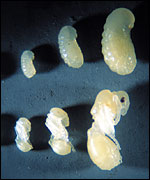
A newly mated queen lays about a dozen eggs. When they hatch 7 to 10 days later, the larvae are fed by the queen. These larvae will develop into small worker ants that will feed the queen and her subsequent offspring. Later on, a queen fed by worker ants can lay from 800 to 1,000 eggs per day if needed. Larvae develop in 6 to 10 days and then pupate. Adults emerge 9 to 15 days later. The average colony contains 100,000 to 500,000 workers and up to several hundred winged forms and queens. Queen ants can live 7 years or more, while worker ants generally live about 5 weeks, although large workers can survive much longer.
In addition to hybrid imported fire ants, there are two kinds of red imported fire ant colonies—the single queen and multiple queen forms. Workers in single queen colonies are territorial. Workers from multiple queen colonies move freely from one mound to another, which has resulted in a dramatic increase in the number of mounds per acre. Areas infested with single queen colonies contain 40 to 150 mounds per acre (rarely more than 7 million ants per acre). In areas with multiple queen colonies, there may be 200 or more mounds and 40 million ants per acre.
The red imported fire ant builds mounds in almost any type of soil, but prefers open, sunny areas such as pastures, parks, lawns, meadows and cultivated fields. Mounds can reach 18 to 24 inches high, depending on the type of soil. Often mounds are located in rotting logs and around stumps and trees. Colonies also can occur in or under buildings.
Colonies frequently migrate from one site to another. A queen needs only half a dozen workers to start a new colony, and can build a new mound several hundred feet away from the previous location almost overnight. Flooding causes colonies to leave their mounds and float until they can reach land and establish a new mound. Colonies also can migrate to indoor locations.
Figure 2. Imported fire ant in comparison to some other common ants
* Competitor species
 Little black ants*
Little black ants* Forelius ants*
Forelius ants* Argentine ants
Argentine ants Crazy ants
Crazy ants Big-headed ants*
Big-headed ants* Imported fire ants
Imported fire ants Native tropical fire ants*
Native tropical fire ants*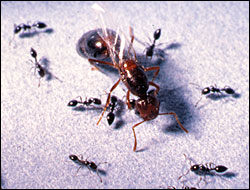 Little black ants attacking fire ant queen.
Little black ants attacking fire ant queen.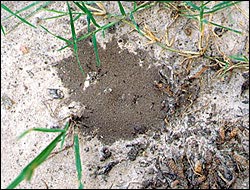 Little black ant nest.
Little black ant nest.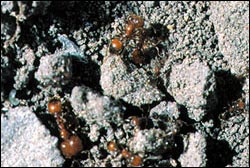 Native tropical fire ants.
Native tropical fire ants.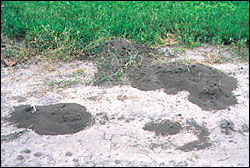 Tropical fire ant mound.
Tropical fire ant mound.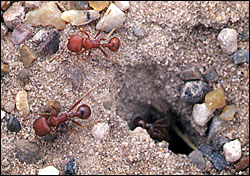 Red harvester ants.
Red harvester ants.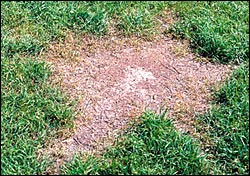 Red harvester nest.
Red harvester nest. Pyramid ant.
Pyramid ant.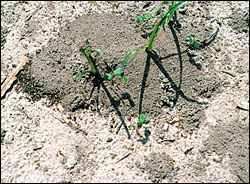 Forelius ant nest
Forelius ant nestMedical Problems

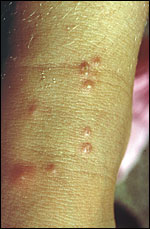
Fire ants are aggressive and will defensively attack anything that disturbs them. Fire ants can sting repeatedly. Symptoms of a fire ant sting include burning, itching and a white pustule that forms a day or two afterward. Often people note a circular pattern of pustules, which may be caused by one ant stinging several times. Although the stings are not usually life threatening, they are easily infected if the skin is broken, and may leave permanent scars.
If the only symptoms are pain and the development of pustules, stings can be treated with over-the-counter products that relieve insect bites and stings.
If a sting causes severe chest pain, nausea, severe sweating, loss of breath, serious swelling or slurred speech, the person should be taken to an emergency medical facility immediately. These are symptoms of an allergic reaction or anaphylactic shock. Some people may lapse into a coma from just one sting. Compared to deaths from bee and wasp stings, relatively few deaths from fire ant stings have been documented.
People sensitive to fire ant stings should seek the advice of an allergist. Once a person has discovered that he/she is allergic to the fire ant venom, extra care must be taken to avoid stings. Often individuals allergic to the venom will carry epinephrin (“Epi kits”) or undergo treatment in an attempt to desensitize their reaction to the venom.
Tips for avoiding medical emergencies and for treating ant stings:
| 1 |
Teach children and visitors about fire ants and their hazard. |
| 2 |
Wear protective clothing during outdoor activities. Wear shoes or boots and/or tuck pant legs into socks. |
| 3 |
Treat stings with an insect bite remedy that deadens pain and protects against infection. |
| 4 |
Control fire ants in areas used most frequently by people and pets. |
| 5 |
Use insect repellents on clothing and footwear (these treatments can temporarily discourage foraging ants). |
History of Control Efforts
More than 65 years ago, the red imported fire ant, Solenopsis invicta Buren, was accidentally brought into Mobile, Alabama, from South America. It now infests more than 275 million acres, comprising most of nine southeastern states and Puerto Rico, with small infestations in Tennessee, Oklahoma, New Mexico and California. Another species, the black imported fire ant, Solenopsis richteri Forel, was also introduced, but the range of this species is limited to northeastern Mississippi, northwestern Alabama and southern Tennessee, with a large population of hybrids between S. richteri and S. invicta that extends into parts of Georgia (Fig. 1). Fire ants can travel long distances when newly mated queens land on cars, trucks or trains, or when winged forms are carried by the wind. Shipments of nursery stock or soil from an infested area may relocate entire colonies or nests.
Why eradication programs failed
Attempts in the late 1960s and early ’70s to eradicate the imported fire ant were not successful. The pesticides used, although effective, were no match against species capable of re-invading previously treated areas. The reasons for failure are debatable, but it is now known that eradication is hindered by the ant’s biology and by problems with treatment methods.
Biological obstacles to eradication
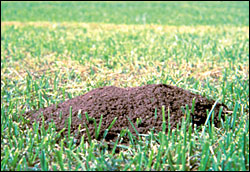
The ants infest such an extensive area that a single treatment would take years and massive resources to apply. Fire ants have a high reproductive rate and disperse easily. Thousands of reproductive females are produced per colony, and the mated females begin a colony wherever they land. Queens can fly up to a mile on their own, or farther when carried by the wind. The ants eliminate competing insects and then rapidly overwhelm an area. Whole colonies can move, and in the multiple queen form, the colonies can split into many new colonies. The queen is protected from many poison baits because she is fed only food eaten first by workers and larvae. If a poison works too rapidly, the worker is killed before the poison is passed to the queen. Finally, worker ants from well-fed colonies may not forage on a bait product, or a bait may not be as attractive as some abundant natural food.
Colonies move vertically and horizontally in the soil profile to escape the effects of flood, drought, and extreme temperatures. When new colonies are not actively foraging, they may be protected from baits or other pesticides applied to the soil surface.
Pesticidal obstacles to eradication
Pesticide treatments are expensive and time-consuming, and there are only three basic approaches. The first is surface treatment using a residual contact poison. This approach is the least environmentally sound because the treated surface remains toxic for a long time. The ants may survive by foraging underground. The second is individual mound treatment, which involves the application of a large volume of pesticide to reach the queen. However, it is nearly impossible to locate all of the colonies in an area, difficult to manipulate large volumes of liquid, and treatment is more expensive and time-consuming. Colonies not eliminated may move or split into several colonies. The third method is bait treatment, which uses some sort of attractive substance the ants like to eat. Unfortunately, baits are not always consumed, and the bait’s attractiveness is short-lived. The bait must be slow-acting and effective over a range of doses, since the dose the ants get cannot be controlled. Baits may also be attractive to and kill some native ant species that compete with fire ants.
Economic, regulatory and environmental obstacles to eradication
The best way to treat large areas (hundreds of acres) is by an aerial application of bait. However, not all areas can be treated because of label restrictions and application limitations. Even with a bait product, it is not feasible to treat the entire infested area or even a large part of a single state, and untreated areas are sources for reinfestation. The larger the treatment area the more slowly reinfestation occurs. If periodic treatments are discontinued, the area may become more infested than it originally was within a year or two because treatments may have eliminated competing ant species.
Table 1. Fire ant insecticides, modes of action and formulations, with generic names of active ingredients and some examples of product names
Baits |
Hydramethylnon (amidinohydrazone) and sulfluramid (n-ethyl perfluorooctanesulfonamide) - These ingredients kill ants by preventing them from converting food into energy. These baits eliminate fire ant colonies within a week when applied to individual mounds, but take several weeks when broadcast. They are also formulated in bait granules and stations. (Amdro®, Siege®, Combat®, MaxForce®, Raid® Ant Baits Plus) |
|
Avermectins (abamectin) - This bait product is derived from a soil fungus and inhibits nerve transmission. As a mound treatment, it kills worker ants and colonies quickly, but as a broadcast treatment it acts more like an insect growth regulator, preventing the production of viable eggs. (AscendTM, ClinchTM, VarsityTM) |
|
|
Spinosyns (spinosad) - These natural metabolite products are produced by a soil microorganism (Saccharopolyspora spinosa) and affect the nervous system. Bait formulations have a speed of activity similar to hydramethylnon and sulfluramid baits. (Eliminator Fire Ant Killer Bait with Conserve®, Penn KillTM Fire Ant Killer and others) |
|
|
Insect Growth Regulators (fenoxycarb, methoprene, pyriproxyfen) - These materials mimic the effects of the insect’s own juvenile hormone, reducing the production of viable eggs and preventing the development of worker ants for up to a year after application. They do not kill adult ants. Treated ant colonies persist for several months after treatment, until worker ants present at the time of treatment die naturally. These products are formulated as a bait to be applied to individual mounds or broadcast. (Award®, Logic®, Extinguish®, Distance®, Spectracide® Fire Ant Bait) |
|
Contact Insecticides |
Botanicals (d-limonene, pyrethrins, rotenone, pine oil, turpentine) - These plant-derived products have various modes of action. D-limonene is a citrus oil extract that kills ants quickly. Pyrethrins, which act on the nerve axon, also kill ants quickly (within minutes to hours) and can be used as mound treatments or surface sprays. Rotenone acts on respiratory tissues, along with nerves and muscles. Pyrethrins and rotenone products break down rapidly in the environment. Rotenone and pine oil (turpentine) products are relatively slow-acting (days to weeks) and are applied as mound drenches. (CitrexTM, Insecto® Formula 7, Organic SolutionsTM Multipurpose Fireant Killer, Organic Plus® Fire Ant Killer and others) |
|
Derivatives of Pyrethrins (allethrin, resmethrin, sumithrin, tetramethrin) - Like pyrethrins, these products destabilize nerve cell membranes and kill quickly, but are quickly deactivated and have little residual activity. They are applied as aerosol injections, mound drenches or surface sprays. (Enforcer® Fire Ant Killer) |
|
|
Pyrethroids (bifenthrin, cyfluthrin, cypermethrin, deltamethrin, fenvalerate, fluvalinate, lambda-cyhalothrin, permethrin, s-bioallethrin, s-fenvalerate, tefluthrin, tralomethrin) - These products also destabilize nerve cell membranes. They can persist in the environment longer than pyrethrins and their derivatives. They are relatively quick-killing and are applied as mound drenches, dusts or surface sprays and granules. |
|
|
Carbamates (bendiocarb, carbaryl) - These materials disrupt nerve transmission (cholinesterase inhibitor). They are relatively quick-killing and are used as mound drenches and surface sprays. (Sevin®, Turcam®) |
|
|
Organophosphates (acephate, chlorpyrifos, diazinon, dichlorvos, fenthion, isofenphos, malathion, propetamphos, propoxur, trichlorfon) - These products also interfere with nerve cell transmission (cholinesterase inhibitor). They are relatively quick-killing. Formulated as aerosols, liquids, dusts or granules, they are applied as mound treatments or surface applications. (Dursban®, Oftanol®, Orthene® and others) |
|
|
Inorganic Compounds - Boric acid is a slow-acting stomach poison. It is commonly formulated as a dust or liquid bait for control of ants. Diatomaceous earth products (D.E., silicone dioxide) are usually applied to ant trails indoors. D.E. abrades the waxy layer from the insect exoskeleton, causing the insect to desiccate. However, D.E. does not eliminate colonies within treated mounds. When D.E. is used as a carrier in formulations of pyrethrins, it may enhance penetration of this botanical insecticide into insect bodies. |
Policy statement for making chemical control suggestions
Suggested pesticides must be registered and labeled for use by the Environmental Protection Agency and the appropriate state Department of Agriculture or regulatory agency. The status of pesticide label clearances is subject to change and may have changed since this publication was printed. County Extension agents and specialists are advised of changes as they occur.
The USER is always responsible for the effects of pesticide residues, as well as for problems that could arise from drift or movement of pesticides from his property to that of others. Always read and follow carefully the instructions on the product label.
The information given herein is for educational purposes only. Reference to commercial products or trade names is made with the understanding that no discrimination is intended and no endorsement by the participating states’ Cooperative Extension Service is implied.
For additional information about imported fire ant management, contact your county Extension agent or visit these World Wide Web sites:
- http://fireant.tamu.edu
- http://insects.tamu.edu
- http://www.aces.edu
- http://www.lsu.edu/ants
Acknowledgments
The authors are grateful for reviews of earlier drafts of this publication by John A. Jackman, Homer Collins,
Linda M. Hooper-Bui, and Jerry Cook.
Produced by Agricultural Communications, The Texas A&M University System; Judy Winn, Editor; Michelle Mikesha, Graphic Designer
 Texas Imported Fire Ant Research & Management Plan Texas Imported Fire Ant Research & Management Plan |
||
|
Bastiaan M Drees, Professor and Extension Entomologist, Texas Fire Ant Project Coordinator/ Texas Agricultural Experiment Station and Texas Agricultural Extension Service, The Texas A&M University System Charles L. Barr, Extension Program Specialist—Fire Ant Project, The Texas A&M University System S. Bradleigh Vinson, Professor, Department of Entomology, Texas Agricultural Experiment Station, The Texas A&M University System |
Roger E. Gold, Professor, Department of Entomology, Texas Agricultural Experiment Station and Texas Agricultural Extension Service, The Texas A&M University System Michael E. Merchant, Associate Professor and Extension Urban Entomologist, The Texas A&M University System Nathan Riggs, Lisa Lennon, Scott Russell and Paul Nester, Extension Agents - IPM (Fire Ant Project), Texas Agricultural Extension Service, The Texas A&M University System |
|
 David Kostroun, Texas Department of Agriculture |
 Kathy Flanders, Extension Entomologist, Alabama Cooperative Extension System, and Assistant Professor, Auburn University |
|
 Beverly Sparks, Professor and Extension Program Coordinator - Entomology, The University of Georgia Cooperative Extension Service |
 Paul M. “Mac” Horton, Professor of Entomology and Assistant Director, Clemson University Cooperative Extension Service |
|
 Dale Pollet, Extension Entomologist, LSU Agricultural Center |
 David Oi, Research Entomologist - Center for Medical, Agricultural and Veterinary Entomology, USDA-ARS |
|
 Donna Shanklin and Kelly Loftin, Assistant Extension Specialists - Natural Resources, Cooperative Extension Service, University of Arkansas |
 Philip G. Koehler, Margie & Dempsey Sapp Endowed Professor of Structural Pest Control & Urban Entomology, University of Florida |
|
 Karen Vail, Assistant Professor and Extension Entomologist, University of Tennessee Agricultural Extension Service |
  J. T. Vogt, Fire Ant Research & Education Specialist, Oklahoma State University |
|
Status and Revision History
Published on Sep 01, 2000
Published on Mar 13, 2009
Published with Full Review on Mar 30, 2012
Published with Full Review on Dec 20, 2016
Published with Full Review on May 18, 2023


























































